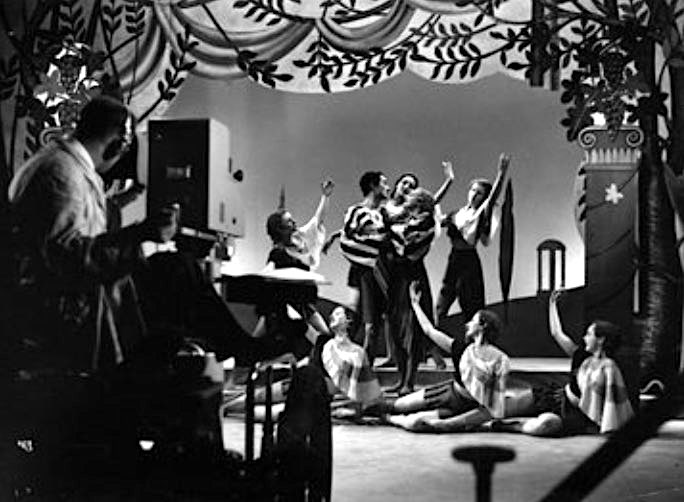OTD in early British television: 27 July 1938

John Wyver writes: Some twenty months after the start of the BBC’s service from Alexandra Palace, Wednesday 27 July 1938 saw the publication, in what was still proudly called the Manchester Guardian, of an absorbing article under the headline, ‘Television Drama: A New Art?’ The author was Marie Seton, a 28-year-old actor, film and theatre critic who two years before had assisted the great Trinidadian writer and activist C.L.R James to mount for the Stage Society his play about the Haitian revolutionary Toussaint Louverture with Paul Robeson and Robert Adams.
Seton is a fascinating figure who in 1939 went on to assemble a cut of the extensive footage that Soviet filmmaker Sergei Eisenstein shot in Mexico towards the unfinished ¡Que viva México! which was released as Time in the Sun. She was a regular contributor to Sight & Sound and wrote a biography of Eisenstein [link to a copy of the 1960 Grove Press edition at Internet Archive]. From the 1950s on she was centrally involved in developing the film society movement in India, and she authored biographies of Jawaharlal Nehru and the Indian director Satyajit Ray [both IA links].
In the summer of 1938 she turned her attention to television drama:
Because this aspect of television is still in an experimental state, with no standards of production and no clearly defined methods of presentation, it is premature to criticise it as a mature art-form comparable to the theatre and the cinema.
In fact television itself has not yet an estalished public, while its technical limitations to-day are relatively the same as those of the film for the first ten or fifteen years after its invention. although the subjects attempted are decidedly more ambitious.
In all discussion of television it should be remembered that thirty years ago no one foresaw what D. W. Griffith, Chaplin, Eisenstein, and Walt Disney would create on the basis of celluloid and a motion-picture camera.
Seton applauded the range of work that AP had tackled over the previous twelve months (several productions of which have been highlighted on this blog), including:
Broadway, one of the first American gangster plays, that appeared in London in 1926; an adaptation of Chaucer’s Pardoner’s Tale, produced as a mime with the words spoken by an unseen actor; Everyman, played in symbolical masks ; also Eugene O’Neill’s study of fear, Emperor Jones, and a modern-dress version of Julius Caesar.
Two other unique experiments were the television versions of act 2 of Tristan and Isolde and Handel’s operetta Acls and Galatea [above], the latter presented for the first time in England since the lifetime of the composer in costume and with scenery.
The critic acknowledged the complexities of television production and the constraints on space and resources at AP:
The limited studio space, particularly for plays in which there happen to be a number of different scenes, means that ·the movement of the actors has to be worked out with extreme precision and executed by them with he greatest care. Should an actor move even a few inches beyond the prescribed lines he is liable to put the scene partly outside the range ofJhe·camera.
Seton offered some astute thoughts about style and approach:
Films have been used in the composition of a number of dramatic productions. A particularly outstanding case was that of Journey’s End, where the bombardment was· shown by a sequence taken from one of Pabst’s films [West Front 1918]. This production was made by George More O’Farrell, who more than almost any other televislon producer is adapting the qualities of the realistic theatre.
There is no doubt that although naturalism may·not produce.the·besf visual effects on the television screen as it is at the moment, it has a compelling quality, because an impression of startling intimacy can be created, particularly by the use of the close-up.
Seton also praised the work of producers Dallas Bower and Stephen Thomas, highlighting that Bower, with a background in cinema, was particularly concerned with the use of the camera, whereas Thomas was more focussed on gesture and movement. And she concluded:
From the point of \iew of the growing.television auqience one thing is certain: although this new invention is mainly designed to be seen at home, it can never have the casual character of the radio. The darkness, essential for good reception, exacts full attention from the spectator. ln this respect television drama is as complete a form of art or entertainent as the theatre or the cinema.
[OTD post no. 222; part of a long-running series leading up to the publication of my book Magic Rays of Light: The Early Years of Television in Britain in January 2026.]
Well, this is a side of Marie Seton I didn’t know, or suspect. Perhaps not surprising that she should praise Dallas Bower, who was already an admirer of Eisenstein – he would buy a copy of ALEXANDER NEVSKY to show trainee Alexandra Palace camera operators. But Seton would become Britain’s foremost Eisensteinian, not only travelling to the USSR to meet and talk with him after the Mexican debacle, but assembling her own ‘rescue version’ of the ill-fated QUE VIVA MEXICO!, titled TIME IN THE SUN. And her biography stood for years as the only reasonably reliable source of information on his life and ambitions. Derek Jarman was one of many admirers.
Today, it’s clear that Seton was really in love with SME, and fancied that he reciprocated her feelings, But aside from this fantasy, it’s still a mine of research and first-hand impressions of Eisenstein in his later years. And TIME IN THE SUN, which is a fine film in its own right, will be included in a forthcoming KinoLorber blu-ray set of the surviving fragments and re-cuts of QVM that I’m helping Bruce Prosner produce, which will also include my TRIP TO TETLAPAYAC.
Excellent – thanks so much, Ian.